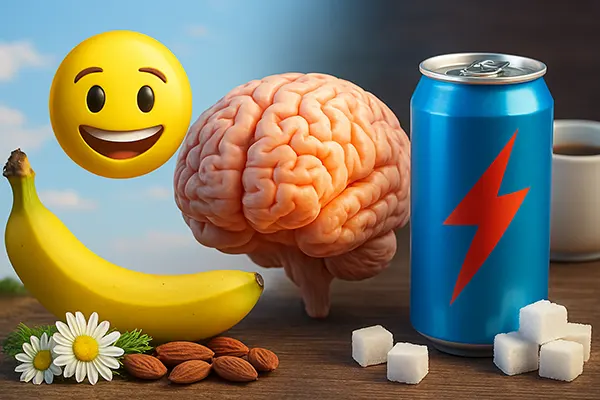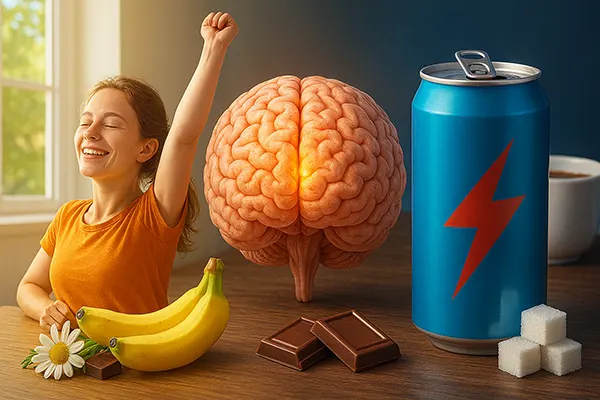Hormones of Happiness vs. Energy Drinks: What Really Boosts Your Mood?

In today’s productivity-driven culture, staying energised and emotionally stable has become a priority for many — especially students, IT professionals, and night-time gamers. Two common ways people attempt to elevate their mood and alertness include relying on energy drinks or fostering the body’s natural “happiness hormones.” But which method is truly effective and sustainable? Let’s compare these approaches based on biological mechanisms, research data, and lifestyle impact.
How Energy Drinks Affect the Body and Mind
Energy drinks work primarily by flooding the body with caffeine, taurine, B vitamins, and sugar. These ingredients stimulate the central nervous system, increase heart rate, and temporarily elevate dopamine levels, giving a sensation of focus and mild euphoria. However, this spike is short-lived and often followed by a crash, leading to fatigue, irritability, or even anxiety.
For instance, a 2023 study published in the journal *Nutrients* confirmed that while energy drinks can improve alertness for up to two hours, they are also linked to increased blood pressure and disrupted sleep patterns — especially among students pulling all-nighters. The same applies to gamers playing through the night; initial boosts in reaction time are quickly followed by cognitive fatigue.
Moreover, heavy consumption of stimulants may lead to dependence and desensitisation, meaning users require larger doses for the same effect. This cycle can strain the nervous system, leaving the individual mentally and physically depleted.
The Downside of Synthetic Mood Enhancement
Unlike natural mood regulation, synthetic stimulation via energy drinks offers no long-term benefits to emotional health. While caffeine and sugar can mimic the release of dopamine and adrenaline, they do not contribute to the brain’s balance of serotonin or endorphins — crucial players in sustained mental well-being.
Regular users may experience withdrawal symptoms such as headaches, mood swings, and decreased motivation. This is particularly concerning for IT workers, whose performance hinges on consistent focus and emotional balance over long hours of screen exposure and problem-solving.
In contrast, natural hormonal activation promotes a more holistic and enduring form of mood enhancement without the side effects of chemical dependency or cardiovascular risk.
How Natural “Happiness Hormones” Work
The body produces several key hormones linked to happiness: dopamine (reward), serotonin (mood stability), endorphins (pain relief and pleasure), and oxytocin (bonding and trust). These are naturally stimulated through physical activity, social interaction, sunlight, music, and healthy food.
For example, even a 30-minute brisk walk triggers endorphin release. Similarly, engaging in creative hobbies, volunteering, or spending time with loved ones can significantly boost oxytocin levels. These natural sources do not overstimulate the nervous system and have no comedown effect.
According to a 2024 review in the *Journal of Affective Disorders*, lifestyle habits that elevate serotonin and dopamine levels — such as regular exercise, balanced sleep, and mindful activities — outperform synthetic stimulants in both short-term mood elevation and long-term emotional resilience.
The Brain’s Reward System and Natural Stimuli
The brain’s reward pathways are designed to respond to consistent, meaningful stimuli. Unlike the spike-and-crash model of energy drinks, natural hormone stimulation creates a more even and sustainable mood curve. Dopamine released during goal achievement or creative tasks leads to a sense of purpose rather than momentary satisfaction.
Moreover, serotonin produced through gut health and exposure to daylight supports stable mood regulation, reducing the likelihood of anxiety and depression. IT specialists working in high-stress, sedentary environments particularly benefit from integrating these habits into their routines.
Night gamers, too, can see long-term advantages from switching late-night gaming marathons and caffeinated drinks with exercise, rest, and serotonin-rich snacks like bananas and dark chocolate.

Real-World Cases and Recommendations
Consider the example of Eva, a 22-year-old computer science student, who swapped her three-daily energy drinks with yoga and morning walks during exam season. Not only did her sleep improve, but she reported better concentration and a more stable mood. Similarly, Pavel, a competitive gamer, transitioned to nootropic teas and added omega-3s to his diet, noticing fewer post-game crashes and better emotional control.
Another case comes from a Kyiv-based IT firm that piloted a “dopamine lunch” initiative — encouraging employees to take short walks, listen to upbeat music, and eat tryptophan-rich foods. After three months, 68% of participants reported lower stress levels and improved cognitive focus.
These examples highlight that natural mood enhancers offer not just mental clarity but also promote better long-term health and productivity — without the risks associated with high caffeine or sugar intake.
Best Practices for Sustainable Mood Management
For students, replacing sugary drinks with green tea, getting enough sunlight, and creating structured study goals can activate dopamine and serotonin systems. These strategies lead to improved memory retention and emotional stability during exams.
IT professionals should focus on micro-breaks, ergonomic workspace setups, and regular meals rich in omega-3s and B vitamins — all of which contribute to hormonal balance and reduce burnout risk.
Night gamers are advised to limit caffeine after 6 PM, use blue-light filters, and incorporate wind-down routines like stretching or breathing exercises to encourage melatonin and serotonin release for better sleep and next-day performance.
